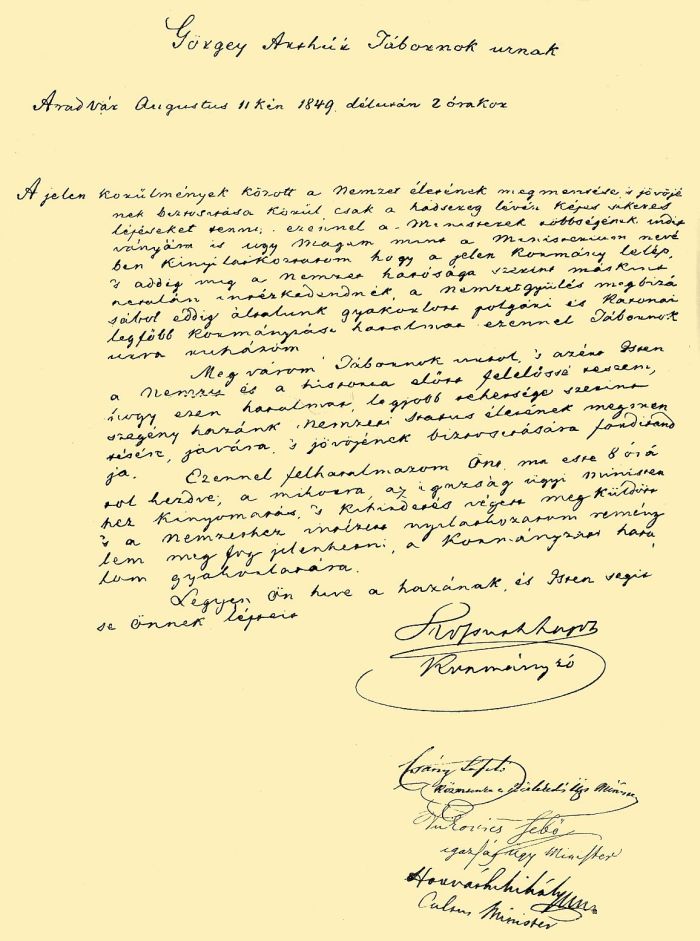Surrender at Világos on:
[Wikipedia]
[Google]
[Amazon]

 The Surrender at Világos, which was the formal end of the
The Surrender at Világos, which was the formal end of the

 After the
After the

 The Surrender at Világos, which was the formal end of the
The Surrender at Világos, which was the formal end of the Hungarian Revolution of 1848
The Hungarian Revolution of 1848 or fully Hungarian Civic Revolution and War of Independence of 1848–1849 () was one of many European Revolutions of 1848 and was closely linked to other revolutions of 1848 in the Habsburg areas. Although t ...
, took place on 13 August 1849, at Világos, (now Șiria, Romania). The terms were signed by Hungarian General Artúr Görgey on the rebels' side and Count Theodor von Rüdiger of the Russian Imperial Army
The Imperial Russian Army (russian: Ру́сская импера́торская а́рмия, tr. ) was the armed land force of the Russian Empire, active from around 1721 to the Russian Revolution of 1917. In the early 1850s, the Russian Ar ...
. Following the capitulation, General Julius Jacob von Haynau was appointed Imperial plenipotentiary in the country and brutally re-subjugated it.
Russian intervention in the revolution

 After the
After the Russians
, native_name_lang = ru
, image =
, caption =
, population =
, popplace =
118 million Russians in the Russian Federation (2002 '' Winkler Prins'' estimate)
, region1 =
, pop1 ...
intervened in the conflict, it was only a matter of time before the Hungarians were defeated, as the Austro-Russians now had far greater military strength. The deciding point came at the Battle of Temesvár, which ended in a decisive Austrian victory, after which the Hungarians' choices essentially amounted to surrender or annihilation. On 21 July, Cavalry Captain Katlaroff and Count Theodor von Rüdiger delivered an offer from Russian General Chruloff to Görgey, who was at Rimaszombat (now Rimavská Sobota
Rimavská Sobota (; hu, Rimaszombat, german: Großsteffelsdorf) is a town in southern Slovakia, in the Banská Bystrica Region, on the Rimava river. It has approximately 24,000 inhabitants. The town is a historical capital of Gömör és Kishon ...
, Slovakia
Slovakia (; sk, Slovensko ), officially the Slovak Republic ( sk, Slovenská republika, links=no ), is a landlocked country in Central Europe. It is bordered by Poland to the north, Ukraine to the east, Hungary to the south, Austria to the s ...
); the offer included total freedom for Hungarian officers and men.
László Batthyány
László () is a Hungarian male given name and surname after the King-Knight Saint Ladislaus I of Hungary (1077–1095). It derives from Ladislav, a variant of Vladislav. Other versions are Lessl or Laszly. The name has a history of being frequen ...
and another officer delivered Görgey's response to Chruloff, in which Görgey demanded that all Hungarians get freedom, not only those who had served in the conflict. He would also gladly accept if one of the Russian princes would wear the Holy Crown of Hungary
The Holy Crown of Hungary ( hu, Szent Korona; sh, Kruna svetoga Stjepana; la, Sacra Corona; sk, Svätoštefanská koruna , la, Sacra Corona), also known as the Crown of Saint Stephen, named in honour of Saint Stephen I of Hungary, was the c ...
(Holy Crown of Saint Stephen).
Surrender
The Hungarian Army surrendered to Russian General Rüdiger on 13 August 1849. At Bohus Castle, they signed the document of surrender. Görgey tried to show by the terms of the surrender that Hungary had been defeated by Russia, and not by Austria. This proved to be pointless as the Russians simply just handed them over to the Austrian authorities.Aftermath
After the surrender and despite the Russian Emperor's pleas for clemency, theAustrians
, pop = 8–8.5 million
, regions = 7,427,759
, region1 =
, pop1 = 684,184
, ref1 =
, region2 =
, pop2 = 345,620
, ref2 =
, region3 =
, pop3 = 197,990
, ref3 ...
engaged in harsh reprisals against Hungary. They sentenced hundreds of soldiers and civilians to death, and imprisoned even more. Prisoners were conscripted into the Austrian Army.
On 6 October 1849, at Arad (today in Romania
Romania ( ; ro, România ) is a country located at the crossroads of Central, Eastern, and Southeastern Europe. It borders Bulgaria to the south, Ukraine to the north, Hungary to the west, Serbia to the southwest, Moldova to the east, and ...
), the Austrians executed twelve Hungarian generals and one colonel, who are known as the 13 Martyrs of Arad
The Thirteen Martyrs of Arad ( hu, aradi vértanúk) were the thirteen Hungarian rebel generals who were executed by the Austrian Empire on 6 October 1849 in the city of Arad, then part of the Kingdom of Hungary (now in Romania), after the H ...
. The same day, they executed Lajos Batthyány, the first Hungarian Prime Minister, by firing squad.
References
* {{DEFAULTSORT:Surrender at Vilagos Hungarian Revolution of 1848